New to Baking? Start Here: Essential Techniques
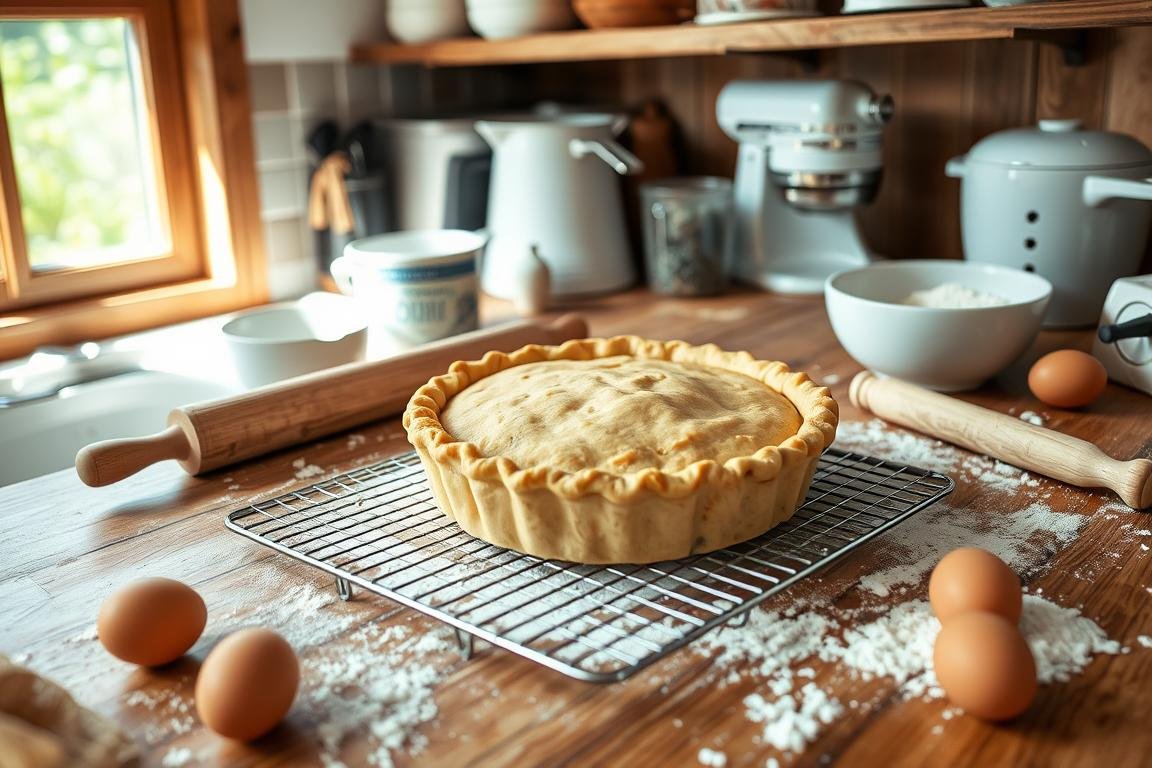
Ever wondered why your home-baked bread doesn’t look like those at the bakery? Or why your cake turned out denser than expected? These issues often come down to whether you’ve mastered essential baking techniques.
Starting your baking journey is more than just making sweets. It’s about learning the science and intricacies of baking. This includes understanding the basics, precision, and baking math. Every well-measured step into techniques for beginners can lead to sweet success.
See this beginner’s guide as your partner in baking. We will explore measurements, mixing methods, and leaveners. They can transform your baked goods from homemade to “Wow! Did you make this?”
Key Takeaways
- Recognizing the role of precise weight measurements in achieving consistent baking results
- Understanding the chemistry behind baking and its effects on recipes, especially when scaling up
- Identifying and executing specific mixing methods such as creaming and whisking for different types of baked goods
- Learning vital techniques like rubbing in and kneading to perfect pastries and bread
- Awareness of common baking terms and the importance of oven readiness for even baking
- Emphasizing the importance of room temperature ingredients and proper preparation of bakeware
- The benefit of embracing baking mishaps as a pathway to gaining expertise
Understanding the Basics of Baking
Starting to bake is thrilling. It mixes being creative with serious science. Knowing the Baking Fundamentals is key. This means learning important techniques and words. Whether making Easy Baking Recipes or fancy sweets, knowing basics means great results.
What is Baking?
Baking uses dry heat to cook food, like in an oven. It’s not only for desserts. Breads and pastries need baking too. Understanding how ingredients react and the need for precise amounts and temps is vital.
Importance of Measurements
Baking needs you to measure things right, more so than other cooking ways. Weighing ingredients leads to better and more reliable outcomes than using cups or spoons.
Eggs, for instance, should be large for balance. This shows why it’s crucial to follow recipes closely. This helps your baking succeed.
Common Baking Terminology
| Term | Description | Example in Baking |
|---|---|---|
| Emulsify | Combining liquids that normally don’t mix evenly. | Integrating butter into egg yolks for a custard base. |
| Leaven | To cause the dough to rise by fermentation. | Utilizing yeast in bread to increase its volume and lighten its texture. |
| Creaming | Beating together ingredients such as butter and sugar until light and fluffy. | Creaming butter and sugar when preparing cookie dough. |
| Folding | Gently combining a light, airy mixture with a heavier one. | Folding whipped cream into a thick chocolate mixture for mousse. |
Knowing Baking Essentials and terms is basic. Whether it’s amazing cakes or simple pancakes, these skills help you grow in baking.
Essential Baking Equipment You Need
To start baking, having the right tools is vital. This goes beyond choosing the right ingredients. Knowing foolproof baking methods to simple baking hacks is helpful. Here are the baking essentials every baker needs.
Must-Have Bakeware
Baking cookies or a big cake needs specific items. The right tools prevent sticking. They also help heat spread evenly in your treats.
| Bakeware Item | Description | Consideration |
|---|---|---|
| Challenger Bread Cloche | High-quality cloche for bread baking | Priced at $299, ideal for artisanal breads |
| Kitzini Baking Mat | Silicone mat for non-stick baking | Top choice after rigorous testing |
| Le Creuset Springform Cake Tin | Perfect for cakes and cheesecakes | Cost-effective at £27.45 |
Kitchen Tools and Gadgets
Correct measurements and mixing matter a lot in baking. Good kitchen tools help you measure precisely. This makes your baking nearly perfect.
- OXO Digital Kitchen Scale – Offers measurements in various units; crucial for precise ingredient quantities.
- Breville Hand Mixer – With 240 watts power, ranked best overall for versatility and efficiency.
- Silicon Spatula Set – Essential for mixing, with heat resistance up to 600˚F.
Oven Essentials
Knowing your oven well is part of using simple baking hacks. You need a good oven thermometer and oven mitts. This helps use baking essentials right.
- Big Red House Oven Mitts – Best overall among tested options, they provide safety and comfort.
- OXO Whisk and Mixing Bowls – Recommended for their quality and utility in preparing various batters and mixtures.
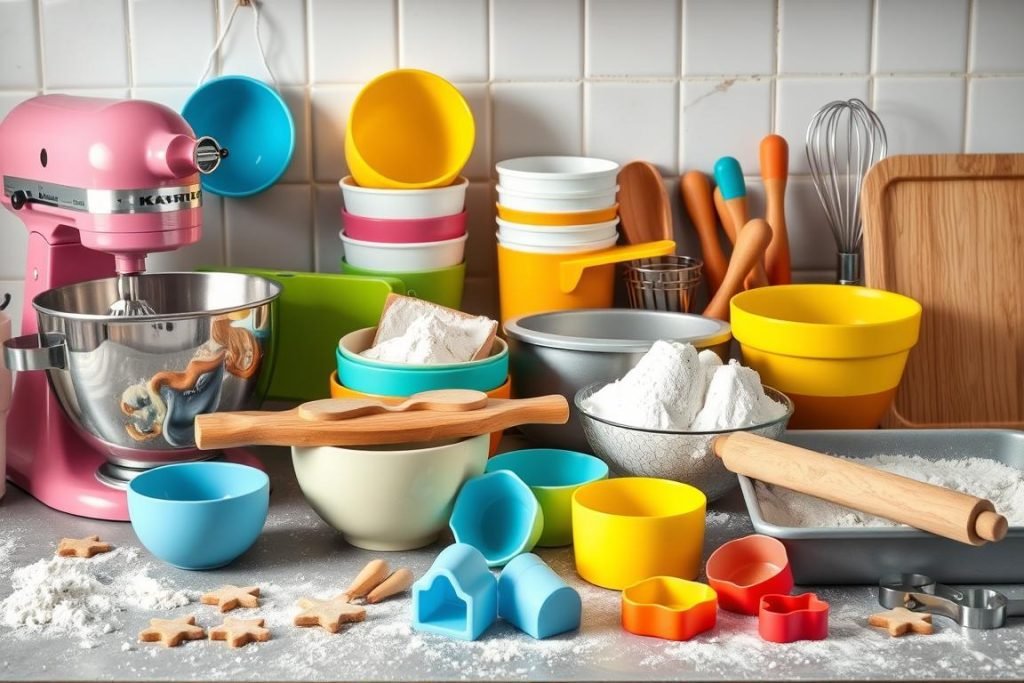
Common Baking Ingredients
Starting in the world of home baking is exciting. Knowing your baking ingredients is key. It boosts your confidence and your treat-making skills. Let’s explore essential ingredients and how they can improve your baking basics.
Flours and Their Uses
Flour gives structure to baked goods. While all-purpose flour is versatile, other types matter too. Whole wheat, bread, and cake flour vary in protein. This affects the texture.
Sugars: Types and Functions
Sugars do more than sweeten in baking. They affect the texture, color, and moisture too. Whether it’s granulated sugar, brown sugar, or liquids like honey or maple syrup, each has unique benefits.
Fats, Liquids, and Leaveners
Fats like butter, oils, and shortening add moisture and flavor. Liquids, whether milk, buttermilk, or non-dairy like almond milk, affect the mix. Leaveners like baking powder and baking soda add volume and lightness.

| Type of Ingredient | Common Varieties | Role in Baking |
|---|---|---|
| Flour | All-purpose, Bread, Cake | Provides structure |
| Sugar | Granulated, Brown, Confectioners’ | Sweetens, adds color and texture |
| Fats | Butter, Shortening, Oils | Adds moisture and richness |
| Liquids | Milk, Water, Non-dairy milks | Bind ingredients, affect consistency |
| Leaveners | Baking Soda, Baking Powder | Helps to rise and aerate |
Knowing these baking basics lifts your baking skills. For new bakers, this knowledge is golden. Use these baking tips for novices to experiment with confidence and get great results.
Baking Techniques Every Beginner Should Know
Starting to bake opens up a fun world of sweets. Learning a few essential baking techniques is the first step. These methods make baking easier and ensure your treats are perfect. Let’s look at basic techniques that use simple baking hacks and foolproof baking methods.
Mixing Methods Explained
Different mixing methods are important for baking. The creaming method is great for cookies and cakes. It makes them light and airy. You beat butter and sugar until fluffy to trap air. This air expands when baked, making a soft dessert.
For flaky doughs and pastries, cutting in fat is key. It keeps fat chunks in the flour. These melt in the oven, creating layers. Remember, timing and precision are crucial in these simple baking hacks.
The Art of Proper Folding
Folding is important when mixing light and heavy mixtures without losing air. Use a spatula to gently combine them. This keeps the mixture fluffy, which is important for soufflés and mousses.
Techniques for Even Baking
To bake evenly, managing your oven’s temperature and tray position is essential. Always start with a preheated oven. Check the temperature with an oven thermometer. Place racks in the center to avoid over-browning.
Rotate your baking sheets halfway through for even cooking. This foolproof baking method helps avoid hot spots in the oven.
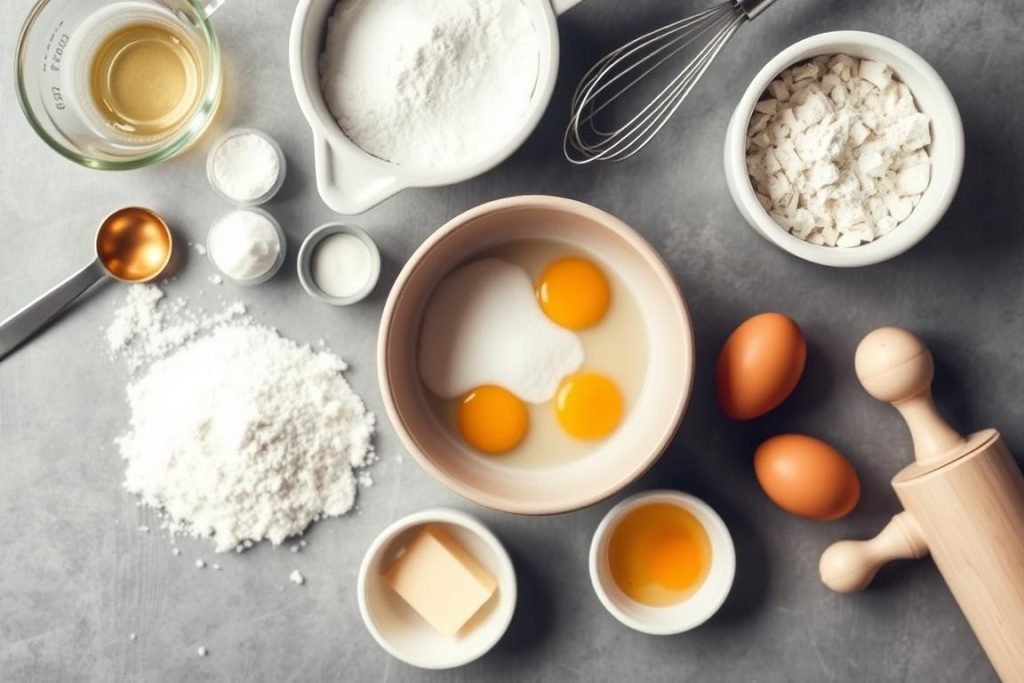
Whether you’re creaming butter and sugar or folding batter, using these essential baking techniques will improve your baking. Keep trying these methods. Remember, the best baking comes from understanding the techniques. Happy baking!
How to Read a Recipe Effectively
Learning to read a recipe well is key to baking well. It helps you understand baking basics and easy recipes. You get to turn complex steps into simple ones. This improves how you follow recipe instructions and manage your oven’s heat.
Understanding Instructions
First, read the entire recipe before starting. Most successful bakers do this. It makes the process clear and highlights special needs like ingredient temperature. Some recipes need room-temp eggs for the right texture.
The order of ingredients matters too. It usually shows how to use them correctly. Following this order stops mistakes like clumps. Nearly all recipes design the ingredient list this way on purpose.

Knowing Your Oven Temperatures
Your oven’s temperature is very important. Know how your oven works beyond the dial. Does it heat evenly? Preheat as recipes say. It’s a must for even baking. Most recipes tell you to preheat for this reason.
Understanding your oven can improve your baking. The right bake often depends on visual clues or a thermometer. Knowing your oven helps follow recipes and apply baking tips. This knowledge is gold.
Using these tips helps you get baking better. You’ll do more than just follow recipes. You’ll understand them fully. This is key for baking great treats every time.
Tips for Perfecting Your Baked Goods
When you start baking, knowing about temperature and timing is very important. These make sure your desserts are amazing. Here are some helpful tips and strategies for new bakers.
Temperature and Timing
Getting the oven right is the first step. Did you know 42% of new bakers don’t check their oven’s temperature? This mistake can ruin your baking. Making sure your oven is hot enough is key. Use an oven thermometer to be sure. Also, 87% of mistakes come from using the wrong amounts. A digital kitchen scale can fix that.
Cooling and Storage Tips
After baking, how you cool and store things matters a lot. Using a wire rack helps 70% of bakers get better textures. It lets air move around the food. For thick items like cheesecake, cool in the pan on a mat. This keeps them soft. Store baked goods in airtight containers to keep them tasty.
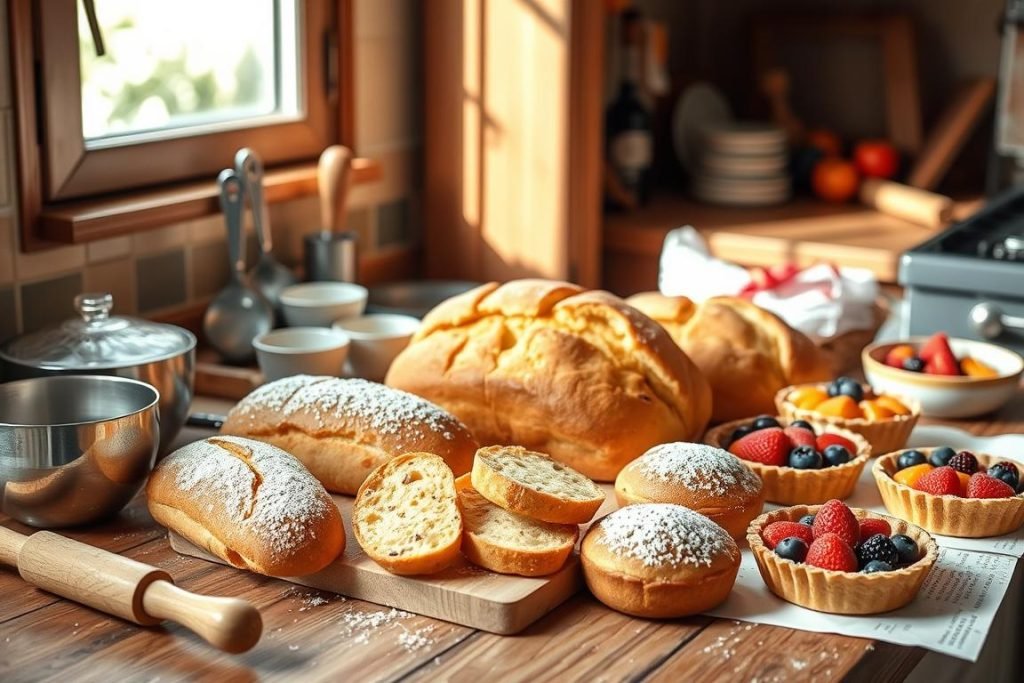
These tips can really improve your baking. Each step in preparation and finishing is important. It makes your baked goods turn out great every time. Happy baking!
Troubleshooting Common Baking Problems
Whether you’re new or experienced, baking issues like overmixing or flat goods can happen. Learning to fix these mistakes makes your baking better. It also adds to your baking basics knowledge. Let’s explore common problems and how to fix them.
Overmixing: Signs and Solutions
Overmixing can make cakes tough instead of fluffy. Look out for dense texture and sinking tops. To avoid this, stop mixing when ingredients are just combined. If you’ve already overmixed, a shorter baking time might help. Overmixing changes gluten, which is important for texture.
What to Do with Flat Baked Goods
Flat cakes can come from old leavening agents or not enough egg whipping. Check that your baking powder and soda are no more than six months old. They lose strength over time. If cakes are still flat, raise the oven temperature for a better rise. Make sure to measure ingredients right, especially leaveners.
To test baking powder or soda freshness, put them in warm water. They should bubble if still good. Knowing these tips, you can face baking issues confidently. You’ll know how to fix them and get better at baking.
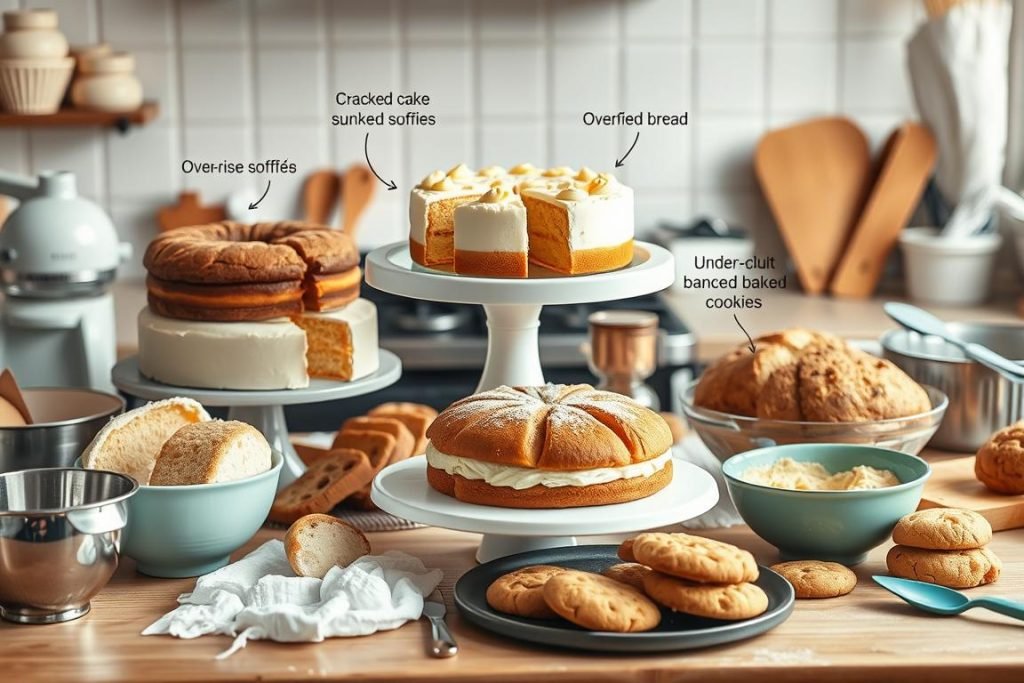
Baking for Special Diets
Mastering various baking techniques for beginners is key when cooking for special diets. It’s important to adapt your skills for those who follow gluten-free or vegan lifestyles. This makes sure everyone can enjoy your treats. Working with different flours and substitutes is both rewarding and kind.
Gluten-Free Baking Options
Gluten-free baking involves more than just changing wheat flour. You must understand how ingredients work together. This affects the taste and texture of what you bake. Using almond flour or gluten-free mixes helps. So does using binders like xanthan gum for the right texture. For beginners, accurate weighing is crucial for great gluten-free baking.
Vegan Substitutes in Baking
Vegan baking has many plant-based options. Replacing eggs and dairy is central to it. Use flaxseed meal or mashed bananas as egg substitutes. Almond milk and dairy-free butters replace dairy. Starting with easy recipes like cookies helps beginners learn. It shows how substitutes change baking results.

Trying special diet baking broadens your skills and promotes inclusivity. Modifying recipes or trying new ones needs creativity and the right know-how. With these baking tips for novices and baking essentials, you’ll cater to diverse diets well. It makes baking satisfying and tasty for everyone.
Expanding Your Baking Skills
Starting to bake at home is very fun. It’s like mixing art and science. Soon, you’ll learn more Complex Baking Skills. Whether you’re new or improving, there are many resources to help you. They help you learn and get better at baking.
Resources for Further Learning
To understand baking better, use good books and courses. For example, learn how to measure ingredients correctly. Knowing about room temperature ingredients is important too. It keeps your desserts from getting too hard or uneven.
Learn about things that make your cakes rise, like baking powder. Using top-notch ingredients, like King Arthur Flour, can improve your baking. Remember, baking well means using the right techniques always.
Getting Involved in Baking Communities
Many people love baking, and there are groups you can join. In these groups, you can share tips, get advice, and join fun baking contests. They talk about how to get perfect baking results every time. Being in these groups helps you learn and love baking more.
If you live in a high place, special tips might help your baking. You can avoid common baking issues. Joining workshops or online chats also helps. It makes your baking journey more exciting.
1 thought on “New to Baking? Start Here: Essential Techniques”